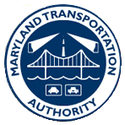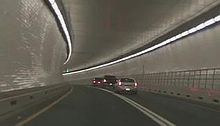- Maryland Transportation Authority
-
Maryland Transportation Authority MdTA seal Agency overview Formed 1971[1] Jurisdiction Maryland Headquarters 2310 Broening Highway, Baltimore, Maryland 21224 Employees 1,700[2] Agency executives Beverley K. Swaim-Staley, Chairperson
Randolph P. Brown, Acting executive secretaryParent agency Maryland Department of Transportation Website http://www.mdta.state.md.us/ The Maryland Transportation Authority (MdTA) is an independent state agency responsible for financing, constructing, operating, and maintaining eight toll facilities, currently consisting of two toll roads, two tunnels, and four bridges in Maryland.[1][3] It also provides the Maryland Department of Transportation with "conduit" financing for other revenue producing transportation projects.[2]
Contents
Agency structure
The MdTA was established in 1971 to take over functions previously performed by the former State Roads Commission.[1] Financially independent from Maryland's general fund and transportation trust fund, the Authority operates as a purely enterprise agency, providing services on a user charge basis similar to the operation of a commercial enterprise. Its capital projects and operations are funded by tolls, concessions, investment income, and revenue bonds.[3][4]
In addition to its own toll facilities, the Authority finances construction of other revenue-producing transportation facilities for the Maryland Department of Transportation (MDOT). These projects have included improvements at the Port of Baltimore and the Baltimore-Washington International Airport. To provide construction funding, the Authority issues revenue bonds, which will be paid off over a period of years by tolls and other user fees generated by the facilities.[2]
The MdTA can issue either taxable or exempt bonds to finance large scale projects. As of June 30, 2010, the Authority had outstanding revenue bonds totaling $2.7 billion. Most of this debt was in the form of transportation facility revenue bonds valued at $1.6 billion, for MdTA toll facilities. Grant and Revenue Anticipation (GARVEE) bonds, secured by federal grants and revenue pledged from individual projects, comprised $651 million of the debt. Conduit revenue bonds, for the construction of transportation parking and airport passenger facilities, also secured by federal grants and the future revenue of specific facilities, comprised the rest of the debt. Unlike the transportation facility bonds, the conduit and GARVEE bonds are pledged to revenue sources managed by other agencies, external to the MdTA.[5]
Governing board
The Maryland Secretary of Transportation serves as chairperson of the Authority's governing board. Eight other board members are appointed to four year terms by the Governor, with confirmation by the Maryland Senate. Term expirations are staggered. Board members can be reappointed to additional terms, but a limit of three consecutive terms was established in 2007.[2][1][6]
Daily operations of the Authority are overseen by an executive secretary, a member of the governing board who serves as the chief executive officer for the agency.[2][7]
Current members of the governing board:[6]
- Beverley K. Swaim-Staley, chair person
- Randolph P. Brown, acting executive secretary
- Peter J. Basso
- Rev. Dr. William C. Calhoun, Sr.
- Mary Beyer Halsey
- Louise P. Hoblitzell
- Richard C. Mike Lewin
- Michael J. Whitson
- Walter E. Woodford Jr. P.E.
MdTA Police
The Maryland Transportation Authority Police, previously known as the Toll Facilities Police, were established in 1971 as part of the MdTA. Their mission includes protecting several other transportation facilities such as the Port of Baltimore and BWI Airport, as well as the Authority's own facilities.[8][1]
Facilities
Currently operating toll facilities
The MdTA operates the following toll facilities:[1]
- Thomas J. Hatem Memorial Bridge – crossing the Susquehanna River on U.S. Route 40 between Harford and Cecil counties
- William Preston Lane, Jr. Memorial Bridge (Chesapeake Bay Bridge) – crossing the Chesapeake Bay on U.S. Routes 50/301 between Anne Arundel and Queen Anne's counties
- Francis Scott Key Bridge – outer crossing of the Baltimore Harbor on I-695, the Baltimore Beltway
- Governor Harry W. Nice Memorial Bridge – crossing the Potomac River on U.S. Route 301 between Charles County, Maryland and King George County, Virginia
- John F. Kennedy Memorial Highway – the 50-mile (80 km) section of I-95 traversing northeastern Maryland from the Baltimore city line to the Delaware state line
- Fort McHenry Tunnel – I-95 crossing the Baltimore Harbor
- Baltimore Harbor Tunnel – I-895 crossing the Baltimore Harbor
- Maryland Route 200 - the Intercounty Connector
Most of the John F. Kennedy Memorial Highway is not actually a toll road. Tolls are collected only on the northbound side, at a toll plaza located a mile north of the Millard E. Tydings Memorial Bridge. Northbound vehicles departing the highway prior the bridge or entering north of the bridge, and southbound vehicles, travel toll-free.[9]
Intercounty Connector
Maryland Route 200, the Intercounty Connector (ICC), will link existing and proposed development areas of Montgomery County and Prince George's County between Interstate 370 at Shady Grove and Interstate 95 in Laurel with an 18 mi (29.0 km) east–west limited-access highway.[10] The $2.4 billion project is being financed by MdTA, with the Maryland State Highway Administration serving as the project manager for engineering and construction.
When the first segment of the ICC opened on February 23, 2011, it became the first toll facility in Maryland with fully automated toll collection. Connecting Interstate 370 with Maryland Route 97, the first segment is 5.65 miles (9.09 km) long.[10]
Express Toll lanes
The MdTA began construction of the Express Toll lanes on a congested portion of Interstate 95, north of Downtown Baltimore, in May 2005. When completed, the new toll system will extend for 8 mi (12.9 km), from the east side of Baltimore City, at the Interstate 895 split, into Baltimore County, north of Maryland Route 43 in White Marsh. This segment of the John F. Kennedy Memorial Highway (Interstate 95) will have two Express Toll and four general purpose lanes in each direction. Tolls for using the Express Toll lanes will vary, depending on traffic conditions, to reduce congestion. The general purpose lanes will continue to operate toll-free.[11]
Other facilities
The MdTA has owned the Canton Railroad, which operates as a for-profit enterprise, since 1987.[12]
Toll increases
Toll increases to become effective at all Maryland toll facilities on October 1, 2011 were proposed by the Authority's board on June 2, 2011. These changes are expected to raise an additional $77 million during the first fiscal year after their implementation. Additional revenue was considered necessary by the board to expand highway capacity and rehabilitate aging infrastructure.[13]
The most recent toll increase was in 2009, but it affected only vehicles with three or more axles. Drivers of passenger vehicles have not seen a toll increase since 2003. When the first span of the Bay Bridge opened in 1952, drivers of passenger vehicles paid $2.80 for the round trip, plus $.25 per passenger; a toll of $2.50 is currently charged for east-bound cars.[13]
References
- ^ a b c d e f "Maryland Transportation Authority". Maryland Manual Online. Maryland State Archives. http://www.msa.md.gov/msa/mdmanual/24dot/html/24agen.html#authority. Retrieved June 7, 2011.
- ^ a b c d e "2010 Strategic Plan". p. 2. http://www.mdta.maryland.gov/About/documents/strategic_plan_small_june_10.pdf. Retrieved June 7, 2011.
- ^ a b "About the Maryland Transportation Authority (MDTA)". Maryland Transportation Authority. http://www.mdta.maryland.gov/About/about.html. Retrieved June 7, 2011.
- ^ 2010 Strategic Plan, p. 5
- ^ Annual Report 2010, pp 6-7.
- ^ a b "Our Governing Body". Maryland Transportation Authority. http://www.mdta.maryland.gov/About/body.html. Retrieved June 7, 2011.
- ^ "Acting Executive Secretary Randy Brown". Maryland Transportation Authority. http://www.mdta.maryland.gov/About/ExecutiveSecretary.html. Retrieved June 7, 2011.
- ^ "Maryland Transportation Authority Police". Maryland Transportation Authority. http://www.mdta.maryland.gov/Police/policeMain.html. Retrieved June 7, 2011.
- ^ "John F. Kennedy Memorial Highway (I-95)". Annual Report 2010. Maryland Transportation Authority. p. 5. http://www.mdta.maryland.gov/About/documents/AR2010.pdf. Retrieved June 10, 2011.
- ^ a b "Intercounty Connector". Maryland Manual Online. Maryland State Archives. http://www.msa.md.gov/msa/mdmanual/24dot/html/24agen.html#intercounty. Retrieved June 7, 2011.
- ^ "Project Overview". I-95 Express Toll Lanes. Maryland Transportation Authority. http://www.i-95expresstolllanes.com/project_overview/. Retrieved June 7, 2011.
- ^ "Other Transportation Ventures". http://www.mdta.maryland.gov/About/othertventures.html. Retrieved June 7, 2011.
- ^ a b MdTA press release (June 2, 2011). "Increases formally proposed for maryland toll facilities". Maryland Transportation Authority. http://www.mdta.maryland.gov/News/NewsReleases2011#06022011. Retrieved June 10, 2011.
External links
Maryland Transportation Authority facilities Bridges Tunnels Highways Railroads  Roads and highways in Maryland
Roads and highways in Maryland 
Highway systems Interstates · U.S. Routes
State highways: (2–199) · (200–399) · (400–599) · (600–799) · (800–999)
State highways shorter than one mile: (2–699) · (700–799) · (800–899) · (900–999)
Former state highwaysHighway agencies Categories:- State agencies of Maryland
- Transportation in Maryland
- Expressway authorities
Wikimedia Foundation. 2010.


